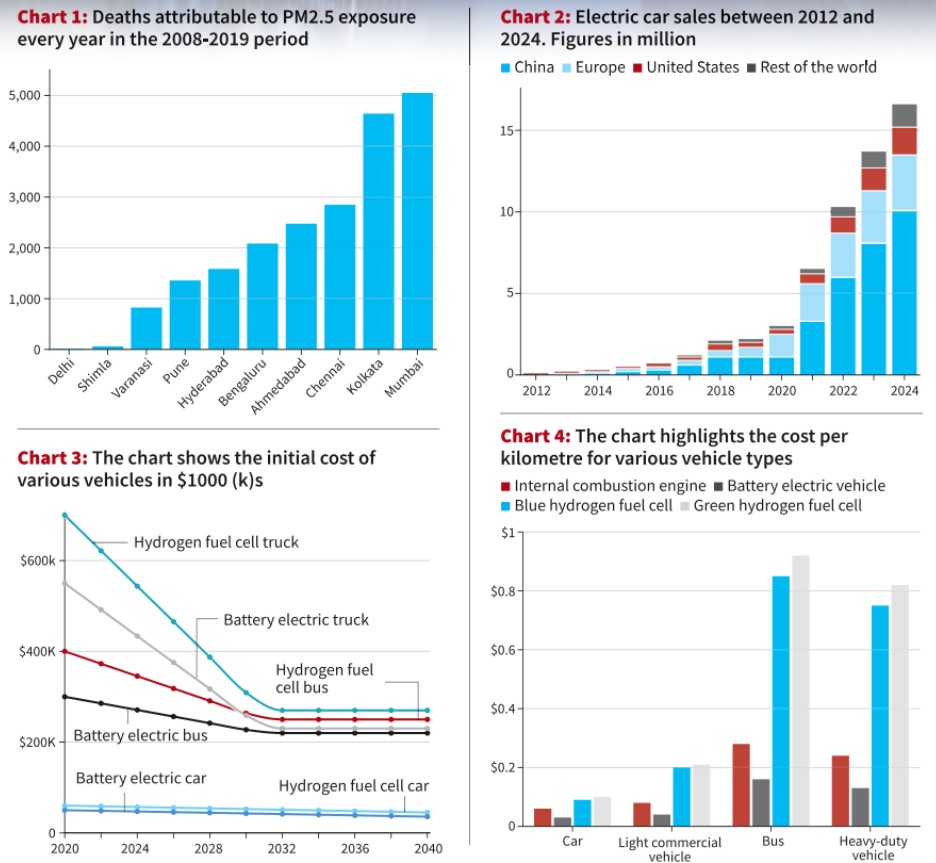Why in the News?
In India, a study published in The Lancet found that between 2008 and 2019, breathing in high levels of PM2.5 air pollution for short periods caused around 30,000 deaths each year in 10 major cities—making up about 7.2% of all deaths in those areas.

What are the major health impacts of urbanisation-related air pollution in Indian cities, as reported by the Lancet study?
|
Why are Fuel Cell Electric Vehicles (FCEVs) considered more suitable for long-distance travel and extreme conditions despite their low adoption?
- Longer Driving Range: FCEVs offer greater range than battery electric vehicles (BEVs) due to the higher energy density of hydrogen fuel. Eg: Hydrogen-powered vehicles can travel 500–700 km on a single tank, ideal for intercity transport.
- Quick Refuelling Time: FCEVs can be refuelled in just 5–15 minutes, similar to petrol or diesel vehicles, unlike BEVs which may take hours to recharge. Eg: Hydrogen buses can be quickly refuelled during breaks, making them suitable for continuous long-haul operations.
- Better Performance in Cold Weather: FCEVs are less affected by cold temperatures, which often reduce the efficiency and range of battery-powered vehicles. Eg: FCEVs are more reliable in regions with harsh winters like high-altitude or Himalayan areas.
- Lighter Vehicle Weight: Hydrogen fuel cells are generally lighter than large lithium-ion battery packs, improving efficiency and payload capacity. Eg: Fuel cell trucks can carry more cargo weight over rugged terrain compared to heavier BEVs.
- Ideal for Heavy-Duty and Rugged Use: Due to their durability and efficiency, FCEVs are well-suited for buses, trucks, and long-range vehicles on varied terrains. Eg: Countries like Japan and South Korea are deploying hydrogen buses for public transport in hilly and industrial regions.
Which countries and regions are leading in global electric car sales and how does India compare?
| Country/Region | 2023 EV Sales | Market Share | Key Highlights |
| China | 9.05 million | 37% of total car sales | World’s largest EV market; accounts for ~58% of global EV consumption |
| Europe | 3.02 million | 24% of total car sales | Strong adoption in countries like Norway, Germany, and the Netherlands |
| United States | 1.39 million | 9.5% of total car sales | Third-largest EV market globally |
| India | 80,000 | ~5% of total car sales | Rapid growth; EV sales nearly doubled in 2023; leading in electric three-wheeler sales |
When will hydrogen vehicle costs match battery-electric vehicles?
- Cost Convergence Expected by 2030: Experts predict that the initial purchase cost of hydrogen Fuel Cell Electric Vehicles (FCEVs) will match that of BEVs by around 2030, due to advancements in hydrogen fuel cell technology and mass production. Eg: A hydrogen-powered bus may cost the same as a battery-electric bus by 2030, narrowing today’s 20–30% cost gap.
- Technology and Manufacturing Scale-Up: As production scales up, the cost of fuel cells, hydrogen storage systems, and related components is expected to fall significantly. Eg: Mass production of hydrogen tanks and cheaper catalysts could lower vehicle costs similar to how lithium-ion battery costs declined over time.
- Infrastructure Development and Government Support: Increased investment in hydrogen refuelling infrastructure and government subsidies are crucial for cost parity. Eg: Japan and South Korea are funding hydrogen highways and offering tax incentives to make hydrogen cars more affordable.
- Operational Costs to Remain High: While initial costs may match BEVs by 2030, running costs are expected to remain significantly higher beyond that due to fuel prices. Eg: Operating a green hydrogen bus currently costs around $0.91/km, compared to $0.17/km for electric buses.
- Limited Market Segments for Parity: Cost matching is likely only in specific segments like heavy-duty transport, not across all vehicle categories. Eg: Long-haul hydrogen trucks may achieve cost parity with electric trucks sooner than passenger cars due to their high utility.
What are the steps taken by the Indian Government?
|
Way forward:
- Enhance R&D and Subsidies: Support innovation and provide financial incentives to reduce the cost of hydrogen vehicles and fuel.
- Build Targeted Infrastructure: Develop hydrogen refuelling stations along key freight corridors and urban hubs.
Mains PYQ:
[UPSC 2024] How do electric vehicles contribute to reducing carbon emissions and what are the key benefits they offer compared to traditional combustion engine vehicles?
Linkage: Electric vehicles (which often implies BEVs) and their role in reducing carbon emissions, aligning with the “clean public transport”.
Get an IAS/IPS ranker as your 1: 1 personal mentor for UPSC 2024

